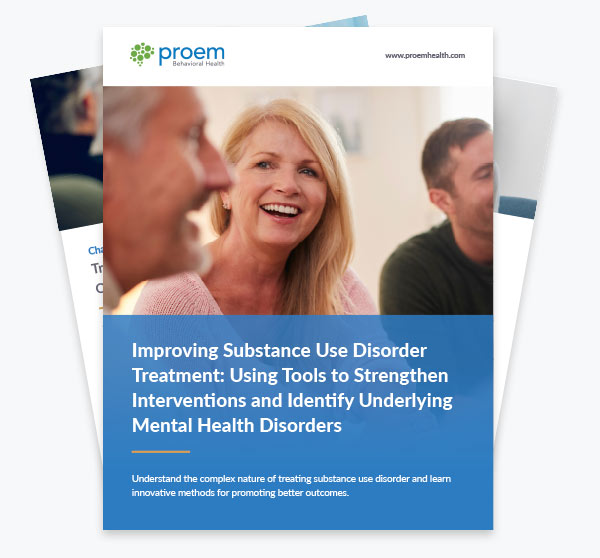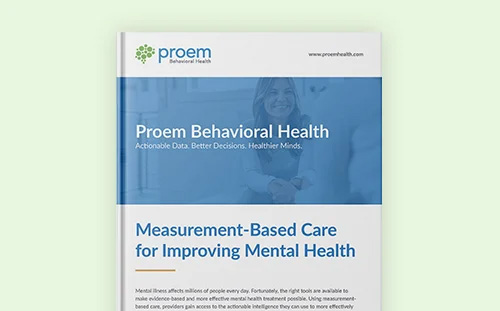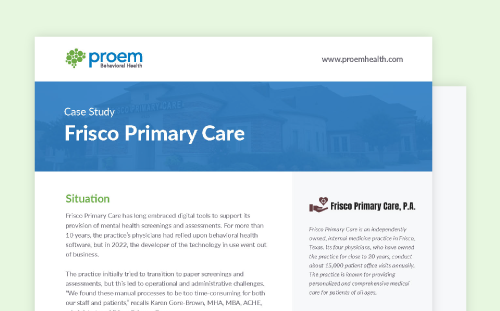Improving Substance Use Disorder Treatment: Using Tools to Strengthen Interventions and Identify Underlying Mental Health Disorders

Understand the complex nature of treating substance use disorder and learn innovative methods for promoting better outcomes.
Read the guide below or download your copy to take on the go.
Substance use disorder (SUD) treatment is complex. Each patient’s situation is unique, and many struggle with co-occurring mental health disorders in addition to SUD. At its best, successful SUD treatment changes patients’ lives and restores futures. However, positive outcomes often result only after providers have tried many options for treatment.
It is possible to overcome challenges. Providers need methods and tools that help them assess overlapping conditions, identify the best treatment strategies and keep patients moving forward.
Digital platforms provide convenient, accessible solutions for providers in all types of specialties. By accurately assessing for SUD and other mental illnesses, today’s evidence-based tools lead to more robust treatment strategies and better outcomes.
This guide examines the common challenges and opportunities around SUD treatment today, with advice for improving outcomes by strengthening the identification and treatment of underlying disorders.
Table of Contents
-
Chapter 1: Treating Substance Use Disorder: Ask the Right Questions to Determine the Correct Level of Care
-
Chapter 2: Removing Barriers to Successful Substance Use Disorder Treatment
-
Chapter 3: Treating the Whole Person: Why SUD Clinics Need to Identify Co-occurring Disorders
-
Chapter 4: Challenges and Opportunities Around SUD Treatments

Chapter 1:
Treating Substance Use Disorder: Ask the Right Questions to Determine the Correct Level of Care
Substance use patterns are on a dangerous upward swing across the U.S. In 2023, 15.35% of American adults reported having an SUD, nearly twice the 7.74% reported in 2022. Universal screening has the potential to flag many more of these at-risk individuals.
5 Tips for Integrating Substance Abuse Screening Tools into Practice
Many patients use substances in risky ways but don’t meet the clinical criteria for diagnosis. To assess SUD effectively, providers must see substance use as a spectrum rather than a binary disease.
1 Implement a three-phase model for substance use disorder assessment.
To help providers reach more people with substance use screening, the Substance Abuse and Mental Health Services Administration (SAMHSA) has developed the three-phase SBIRT approach to substance use disorder assessment. Those steps are:
-
Screening
-
Brief Intervention
-
Referral to treatment
The screening phase uses brief tools, including one to three substance use evaluation questions. These questions evaluate risk and recommend further assessment if necessary. If the patient needs and is motivated to engage in specialty care, the provider initiates a referral for the appropriate treatment type. With this systematic approach, patients of all risk levels can receive proper care.
2 Integrate screening for co-occurring disorders.
Of the 47.6 million adults who reported a recent mental illness to SAMHSA, 19.3% had a co-occurring SUD, compared to only 5% of those without a mental illness. Conversely, research suggests that between 33% and 60% of people seeking substance use treatment also have a mood or anxiety disorder.
Routine screenings and assessments allow substance use disorder clinics and providers to identify SUD and co-occurring mental health disorders more effectively, reducing the likelihood of symptom misattribution. Providers can more easily identify new and worsening mental illness in patients with SUD, and risky substance use patterns in patients with mental health diagnoses become easier to treat.
3 Implement universal screening to improve patient outcomes.
According to SAMHSA, Treatment Improvement Protocol 42, “without timely and effective screening and assessment, the chances of clients receiving appropriate care decrease significantly.”
Accurate diagnosis is essential for effective treatment, yet patients may not advocate for the necessary interventions. Almost universally, patients who reported not receiving addiction treatment did not believe they needed it. Yet, 16.5% of people ages 12 and older met the criteria for an SUD in that same year.
A lack of treatment leaves SUD patients vulnerable to poorer outcomes across domains. Increased risks include accidental injury, overdose, attempted suicide and heart disease.
4 Establish trusting relationships with patients.
Patient trust is essential to effective information-gathering. SUD clinics and providers must cultivate that trust by conveying compassion and non-judgmental curiosity when discussing mental health and substance use challenges. These qualities encourage patients to disclose their substance use habits and honestly indicate their readiness to change.
When providers accurately identify patient motivation and readiness for change, they can design more appropriate and realistic treatment plans.
5 Use evidence-based substance use screening tools.
Clinically validated screening tools provide essential objectivity in the assessment process. Most importantly, these tools are standardized and consistent across patient populations, ensuring that each patient responds to the same questions.
Digitization has made evidence-based tools more accessible to patients and providers. SUD clinics and providers can use these tools to assess for SUD and mental health disorders as part of their standard intake processes.
of people ages 12 and older met the criteria for an SUD.
Substance Abuse Assessment Tools: Know Your Options for Better Outcomes
Substance use disorder screening tools build a picture of patients’ substance use and mental health patterns. Access to a broad selection of tools is essential, as each one targets different issues and is appropriate for specific populations.
Evaluating Screening and Assessment Instruments
Preliminary screening and in-depth assessment both depend on clinically validated behavioral health tools. Providers must use instruments rated highly on assessment quality measures to avoid misdiagnosis and symptom misattribution.
SUD clinics and providers must also consider whether their patients can and are willing to complete a screener. Shorter questionnaires may cause less resistance and encourage more willing disclosure.
Easily administered substance use disorder assessment tools may also receive more buy-in from clinics and administrators. The less disruption to the overall clinical and administrative workflow, the more quickly an organization can adopt an instrument.

Common Drug and Alcohol Screening and Assessment Tools
Understanding available substance use disorder assessment tools is the first step to choosing the most appropriate options. The National Institute of Drug Abuse publishes a chart introducing popular tools, their purpose and administration details. Some are substance-specific, while others consider both alcohol and drug use.
Alcohol Screening Tools
Several popular screeners exclude drugs and focus on alcohol use. They include:
-
CAGE
Evaluates whether people have tried to (C) cut down on drinking, (A) annoyed loved ones with their drinking, felt (G) guilty about the amount of alcohol they drink, or needed an (E) “eye-opener.”
-
Alcohol Use Disorders Identification Test (AUDIT)
Identifies harmful or risky drinking but is not based on diagnostic criteria.
Drug Screening Tools
The market offers the following drug-only screeners:
-
Drug Abuse Screening Test (DAST-10)
Assesses the degree and impact of drug misuse in adults and older adolescents.
-
Opioid Risk Tool (OUD)
Screens for potential consequences of the patient taking an opioid medication.
Non-alcohol screening tests may be appropriate for patients who have already completed an alcohol use screener or have an existing SUD diagnosis related to non-alcohol substances.
Substance Use Disorder Assessment Tools
An inclusive substance use disorder screening tool reduces the number of forms necessary, simplifying the process for clinicians and patients of all ages. There are many choices in this category, including:
-
Urge to Use Scale
Measures the "urge to use" aspect of recovery, asking questions in the timeframe of the past week in six questions.
-
Tobacco, Alcohol, Prescription Medication and Other Substance Use (TAPS)
Screens and provides a brief follow-up assessment.
-
Alcohol, Smoking and Substance Involvement Screening Test (ASSIST)
Screens for substance use issues in community medical settings.
-
UNICOPE
Screens for feelings and behaviors related to substance misuse.
-
Personal Experience Screening Questionnaire
Assesses the severity of substance use in adolescents.
These instruments assess substance use and its effects. Additional tools are necessary to screen for co-occurring disorders.
Assessing Co-occurring Disorders in Clinical Settings with the M.I.N.I.
Screening for mental illness is a best practice when patients have suspected or confirmed SUD. The Mini International Neuropsychiatric Interview (M.I.N.I.) and the M.I.N.I. Kid for pediatric patients are clinically validated tools that effectively identify common mental disorders. When added to clinical workflows, the M.I.N.I. can indicate the co-occurring depression, anxiety or other mental health disorders that the patient meets criteria for, improving the accuracy of diagnosis and treatment.

Chapter 2:
Removing Barriers to Successful Substance Use Disorder Treatment
The frequent co-occurrence of SUD and mental illness is one of several obstacles to effective treatment. The vulnerability of adolescent patients and pervasive societal stigma are two essential others. However, with a careful approach, these issues can be mitigated to realize positive outcomes.
Overcoming Stigma to Improve SUD Assessment and Treatment
Although approximately one in seven Americans confirms having an SUD, stigma still prevents many from seeking help. Providers have the chance and responsibility to counteract that stigma. Here are nine tactics to help overcome this barrier.
1 Establish the primary care office as a safe space.
Primary healthcare providers are a typical patient’s entry point to the medical system. Universal screening is a powerful method for identifying more instances of risky substance use, but only if patients feel comfortable answering honestly. For that to happen, every patient conversation must be help-oriented and judgment-free.
2 Build trusting provider-patient relationships.
When researchers asked why patients feel uncomfortable disclosing substance use, two top reasons were confidentiality concerns and fear of adverse provider reactions. Many worried that their providers would treat substance use as a personal failing rather than a medical problem. All providers must counteract these assumptions by displaying unconditional positive regard for the patient as an individual, no matter the topic.
3 Create a judgment-free environment.
Many patients enter a provider’s office expecting blame and judgment for risky behaviors. Visual messages, such as posters and pamphlets, can change the patient’s expectations before the provider enters the room. Those visuals should have validating messages, emphasizing the commonality of substance use challenges and the potential for recovery.
Fault-free language is also essential for the patient and provider. According to a study by the Recovery Research Institute, people generally feel more hopeful and less dismissive of someone with “a substance use disorder” (SUD) than a “substance abuser.” Emphasizing SUD as a treatable disorder helps all parties adopt a positive mindset.
4 Understand substance use stigma among staff.
Even trained clinicians are susceptible to stigma against substance misuse. On average, patient-regard scores are lower for individuals with substance dependence than for those with physical conditions. A fault-free experience is impossible unless providers address this stigma, even if clinic workers refrain from expressing it directly.
5 Educate clinicians for a stigma-free patient experience.
Many providers feel unprepared to treat patients with SUD. This lack of knowledge can lead to an avoidance of substance-related topics or, in worse cases, active stigma against patients with risky substance use patterns. Professional education fills the gap, giving clinicians the tools necessary for compassionate care.
6 Reduce institutional stigma.
Education can affect care quality and outcomes on an institutional level. All patient-facing and non-patient-facing staff members benefit from learning about addiction processes, best care practices and the overall high recovery rate.
7 Integrate substance use treatment and other forms of healthcare.
Ongoing stigma has created and maintained a separation between SUD treatment and medical care. Research indicates this separation is contraindicated, while integrated SUD treatment and primary medical care drive better outcomes overall. Integrated treatment also allows for cross-discipline anti-stigma training, which powers judgment-free care.
Mental health concerns are widespread in patients with substance use disorder. In one study, researchers concluded that four out of five SUD patients had moderate to severe depression or anxiety.
Unfortunately, misdiagnosis and symptom misattribution are common among patients with co-occurring conditions. Evidence-based mental health and SUD assessment is essential to putting patients on the correct treatment track. With an accurate diagnostic picture, providers can offer expert-recommended integrated treatment.
8 Strengthen outcomes with support and care coordination.
Integrated treatment improves outcomes for patients with substance use disorder and depression, anxiety and other mental illnesses. In one study, patients who received collaborative care were more than twice as likely to receive SUD treatment and less likely to relapse than patients in a siloed system.
Outcomes improve further when patients receive continuing care in recovery. Communication must remain strong throughout the follow-up process, and all providers involved must have adequate training.
9 Start strong with effective and judgment-free screenings.
A successful treatment process begins with an accurate diagnosis requiring thorough evaluation. Universal SUD assessment reaches as many patients as possible while reducing stigma by making evaluation routine.
Assessment is not universally standard yet, but the availability of integrated digital screening tools has improved the picture. By making questions easier to answer and the answers easier to share, these tools remove barriers to screening every patient — this includes adolescent patients, who have unique concerns that must be addressed.
What to Know About Assessing and Treating Substance Abuse in Adolescence
Substance misuse in adolescence is on the rise, and so are its consequences. Between late 2019 and late 2021, overdose deaths among 14- to 18-year-olds in the U.S. increased by 109%. More than 40% of those who died showed signs of mental illness.
Consequences of SUD in Adolescence
Adolescents are more vulnerable than adults to certain effects of substances. According to SAMHSA’s advisory on adolescent substance use:
“Adolescents with untreated or undertreated substance use disorder (SUD) are at risk for experiencing adverse outcomes into adulthood, including criminal involvement, sexually transmitted infections, unintended pregnancy and co-occurring mental disorders. Furthermore, adolescent substance use is associated with violence and unintentional injury — two of the leading causes of death for this population.”
Researchers have also linked drug use in early adolescence with reduced cognitive performance and abnormal neurological function. Their executive control abilities are particularly vulnerable, as substances can compromise related nerve connections. Fortunately, adolescent neurological development also makes this a beneficial period for treatment.
Factors Contributing to Adolescent Substance Use
Adolescents’ developing rational brains put them at risk of risky substance use patterns. Some young people are even more susceptible because of individual stressors, and clinicians must know these patterns.
Adverse Childhood Experiences: Trauma and Substance Use
Adverse childhood experiences (ACEs) increase the risk that an adolescent will use substances. Each ACE in an adolescent’s history doubles the likelihood of substance use, and four or more make a young person extremely vulnerable to addiction.
According to the Centers for Disease Control and Prevention, 64% of people experience at least one ACE before age 18. ACEs may include:
-
Physical, sexual or emotional abuse
-
Emotional or physical neglect
-
Parental divorce or separation
-
Mental illness or substance misuse in the household
By identifying and addressing trauma histories, clinicians may be able to intervene earlier in substance misuse situations.
Co-occurring Mental Health Conditions
Mental illnesses are common among adolescents with diagnosable SUD and sub-clinical risky substance use. According to the Child Mind Institute:
of youth with SUD also have a mental health disorder.
In another survey, among young people aged 12 to 17 with a recent major depressive episode, more than 28% reported using substances in the same year. Only 11% of those without a recent episode made a similar report.
A reported 56% of adolescents with co-occurring conditions received treatment for at least one disorder, but more than 93% only received mental health services. Programs that do treat substance use disorder may insufficiently address psychological problems, leading to worsening symptoms. Mental health providers and SUD clinics need to work together and provide integrated treatment for all presenting issues.
A Multidisciplinary Approach to Treatment
The National Institute on Drug Abuse (NIDA) recommends an integrated, whole-person approach to adolescent SUD and co-occurring conditions. The ideal treatment team will include experts on each issue, working alongside family and community members who understand the child and their needs.
Few providers have the tools to identify all presenting issues with an introductory interview, so a reliable screening process is essential. Adding universal screening to the well-child visit is a reliable way providers can identify more young people in need of treatment, as 89% of youth under 18 have these visits. Universal screenings are fair, unbiased and more effective than subjective risk level assessments.
Basic screenings also allow providers to flag diagnosable disorders and lower levels of symptoms or substance use. Identifying SUD through a multi-disciplinary approach is also helpful in addressing co-occurring disorders. Let’s explore further.
Mental Health and Addiction: How SUD Clinics Can Address the Overlap
Substance use disorder and mental illness affect each other in various ways, making causality difficult to determine. Both disorder types have shared genetic and environmental risk factors, and the presence of one may trigger the other.
In some individuals, substance use leads to neurological changes. Those changes may escalate existing symptoms to a clinically significant level or prompt new symptoms to develop. Other patients develop disordered substance use by self-medicating mood or anxiety disorders.
Co-occurring SUD and mental health issues present differently in every patient. A multidisciplinary, patient-focused approach is essential for optimal outcomes.
SUD Mental Health Care: The Integrated Approach
Siloed mental health and addiction treatment fails to address the complex interactions involved. An integrated treatment approach lets providers view each patient’s clinical picture and make informed decisions.
An integrated treatment specialist oversees a multidisciplinary care team in this expert-recommended model. The group develops a patient-centered treatment plan that connects each aspect and type of treatment. Instead of making the patient travel between disconnected providers, the team can create a unified strategy incorporating all relevant factors, including medications and trauma influences.
Advantages of Trauma-Informed Care
SUD and mental illness often appear in individuals with trauma histories. Those histories affect all aspects of a patient’s treatment journey, including whether specific approaches succeed or fail. Yet, providers can easily miss those histories when focusing on other symptoms.
An integrated treatment approach helps the treatment team to consider the possibility of trauma at every stage, from screening to follow-up. A positive trauma screening should prompt clinicians to deliver trauma-informed care, which SAMHSA recommends for optimal outcomes. Evidence suggests that trauma-informed treatment reduces symptoms and improves quality of life for patients with addiction and mental health challenges.
Role of Medication-Assisted Treatment (MAT)
Medication supports recovery for many patients with SUD and co-occurring mental illness. For example, in those with opioid use disorder, the appropriate drug can reduce the risk of death, improve quality of life and decrease the likelihood of other substance use.
Some pharmaceuticals designed for mental illness treatment may affect SUD and vice versa. To choose appropriate medications, providers must understand each patient’s complete diagnostic picture. An integrated treatment approach makes this process easier while reducing the risk of error.
Coordinating Care Delivery for Better Outcomes
Integrated treatment requires collaboration among treating providers and organizations. With effective communication, cross-disciplinary teams can develop patient-centered strategies.
Education and Skills Training
Providers in SUD clinics see as many serious mental illnesses as those in mental health treatment facilities. Yet, according to the National Institutes of Health (NIH), providers in these traditionally separate systems often fail to provide appropriate care for co-occurring conditions.
This treatment gap stems largely from a lack of education in conditions outside the treatment silo. To provide adequate care, staff in SUD clinics and mental health treatment centers need professional training in both diagnosis types. Staff members must learn how these conditions present in patients, whether alone or co-occurring.
Dual-Diagnosis Screening
Accurate diagnoses are essential to effective care across mental health and addiction treatment settings. According to SAMHSA’s Treatment Improvement Protocol for trauma-informed care:
“Behavioral health professionals without specific assessment training can still serve an essential role in screening for possible mental disorders using established screening tools. In agencies and clinics, it is critical to provide such screenings systematically — for each client — as PTSD and other co-occurring disorders are typically underdiagnosed or misdiagnosed.”
Evidence-based behavioral health tools make universal screening possible. They allow those without extensive specialized expertise to assess for SUD and mental illness, recommending further action and referrals where necessary.

Chapter 3:
Treating the Whole Person: Why SUD Clinics Need to Identify Co-occurring Disorders
By NIDA’s calculations, 37.9% of adults with SUD also have some mental illness. Depression, anxiety and bipolar disorder are the most common co-occurring diagnoses.
The Link Between Depression and Substance Abuse: 5 Facts to Know
Understanding the connection between depression and addiction is the first step to effective dual diagnosis treatment. These five facts are essential for clinicians and healthcare organizations.
1 Multiple substances increase the risk.
The bi-directional link between depression and SUD is stronger for people who use multiple substances. Individuals with alcohol and cannabis dependence are more likely to develop major depressive disorder (MDD) than those with only one dependence. To effectively evaluate risk and develop treatment plans, clinicians need tools that screen for multiple substances.
2 Influence is bi-directional and complex.
Depression and substance misuse have multiple causal and influential pathways. Depression may lead to risky substance use that escalates to SUD, just as the distress of SUD can develop into depression.
Environmental and medical factors also play a role. For instance, having chronic pain and depression increases a person’s risk of opioid misuse. Ongoing discomfort may increase depressive symptoms, which leads to further loss of function. This cycle, combined with a need for pain mitigation, can easily lead to a substance use disorder.
Such complex patterns of interaction are common in multiple-diagnosis situations. The first step is diagnosing all contributing psychological and substance-related illnesses, whether a root cause is apparent.
3 Co-occurrences are higher among certain populations.
Adolescents and individuals of lower socioeconomic status are more vulnerable to depression and substance misuse.
Unfortunately, less than 12% of adolescents with dual diagnoses receive treatment for both conditions.
Additionally, young adults with depression and substance use disorder have higher rates of unemployment and lower future incomes than peers with one or neither diagnosis. Widespread screening allows providers to guide more at-risk young people into treatment and improve their outlook.
4 Self-medication is a common contributing factor.
Many patients experience depression before developing a substance use disorder. In one study, depression preceded substance use for 70% of patients.
Primary depression is a significant risk factor for self-medication, in which an individual uses substances to relieve mental illness symptoms. Researchers have observed this pattern in up to 24.1% of study participants. Routine substance use screening, especially for those with depression risk factors, may halt this dangerous pattern.
5 Depression and addiction share multiple risk and protective factors.
Certain medical and environmental factors increase a person’s risk for depression and substance misuse. Those factors include:
-
Bullying or mistreatment from peers
-
Lack of adult supervision as a minor
-
Childhood abuse, violence, or loss
-
A family history of mental illness or substance use
Experiences opposite to these risk factors may protect against substance use and depression. For instance, adults with strong social connections in childhood are more likely to be mentally well. Early treatment is also a protective factor, supporting universal screening as a best practice.
Anxiety and Substance Abuse: Treating Co-Occurring Disorders
In any yearlong span, 33% to 45% of individuals with generalized anxiety disorder will have co-occurring SUD. The more clinicians learn about these commonly diagnosed conditions, the more prepared they will be to treat dual diagnoses.
Pathways for Co-occurrence
Anxiety and substance misuse have complex causal pathways. According to findings published in Clinical Psychology Review:
“Prospective studies show that having either an anxiety disorder alone or an alcohol use disorder alone predicts the later development of the other. … Either an anxiety disorder or alcohol dependence can serve as a causal stimulus for the other and… anxiety disorder can contribute to the persistence of pathological alcohol use."
The causation between anxiety and addiction can be challenging to determine, but the following four pathways are common.
1 Alcohol and Mental Health: Neurological Connections
Substances with abuse potential can impact the neurotransmitter systems that cause anxiety. These effects may build up and escalate symptoms to the clinically diagnosable level.
This escalation may happen more quickly if the person develops a tolerance. When the body’s response to a substance diminishes, many patients take more to achieve the same effect. With more of the substance in the body, anxiety and addiction can intensify.
2 Self-Medication in Individuals with Anxiety
Patients who self-medicate may experience worsening symptoms. Self-medication does not cause addiction, but it can encourage consumption at a level that leads to dependence. Tolerance also plays a role, as it requires more of a substance to have the same self-medicating effects.
3 Withdrawal as an Anxiety Trigger
High substance use levels increase an individual’s risk of withdrawal, which may cause symptoms of anxiety and agitation. According to Clinical Psychology Review, these symptoms may “initiate a vicious feed-forward cycle of increasing anxiety symptoms and alcohol use that results in comorbidity.” Close tracking of SUD patients’ anxiety and substance use patterns can assist clinicians in breaking this cycle.
4 Shared Neurological Factors in Anxiety and Addiction
Anxiety disorders and SUD share many symptoms, including restlessness, hyperactivity, hypervigilance and irritability. This significant overlap suggests a potential common cause, such as a neurological difference that affects stress and fear reactions. This type of neurology can inhibit a person’s ability to process stress, causing a predisposition to anxiety or substance use.
Such neurological changes may have a genetic root. Researchers believe that environmental stressors, such as a family member’s anxious behaviors, may lead to genetic modifications that parents can pass on to their children.

Treating Bipolar Disorder and Substance Abuse: 5 Things to Know
Like depression and anxiety, bipolar disorder interacts with co-occurring substance use disorder in many ways. The following patterns can help clinicians understand how the two diagnoses can present.
1 Bipolar and substance misuse frequently co-occur.
Bipolar disorder is the most common dual diagnosis among patients with SUD. Researchers have estimated that 22% to 59% of individuals with bipolar disorder will develop SUD in their lifetimes, and multiple studies have shown that SUD increases the risk of a bipolar diagnosis.
Researchers have estimated that
22% to 59%
of individuals with bipolar disorder will develop SUD in their lifetimes.
As in any dual diagnosis situation, establishing individual causality can be difficult but is rarely necessary. Awareness of co-occurrence risk is enough to prompt assessment in patients with either disorder.
2 Manic episodes increase substance use risk.
Substance use is a common risky behavior of choice for people experiencing mania, and those with manic experiences are 8.4 times more likely to develop drug dependence compared to the general population. Those with hypomania, seen in patients with bipolar II disorder, are 3.6 times more likely to develop alcohol or drug dependence.
Likewise, an SUD history may increase an individual’s tendency toward risk-taking behavior. Researchers have linked this tendency to a lower loss resistance and a more pessimistic outlook. Awareness of these connections could help providers flag more instances of SUD, mania and bipolar disorders.
People with manic experiences are
8.4x
more likely to develop drug dependence compared to the general population.
3 Individuals with bipolar disorder may self-medicate.
Researchers have observed self-medication patterns in 41% of patients with bipolar I and 34.7% of those with bipolar II disorder. As with anxiety and depression, the pattern is likely to continue if substances provide the anticipated relief. If substance use “controls” symptoms to a patient’s satisfaction, they may be more likely to use substances and less likely to seek help.
Bipolar disorder also presents the unique risk of patients using substances to experience mania versus depression. Depressive symptoms are likely to return with cessation, particularly if dependence develops and the patient experiences withdrawal.
Self-medication may occur and develop into disordered use even without a clinical diagnosis, and the highs and lows of chronic substance use may mimic bipolar symptoms. Clinicians should be careful to screen for both bipolar disorder and SUD to avoid misdiagnosis.
4 Substance misuse may exacerbate bipolar symptoms.
Regardless of why a patient with bipolar disorder uses substances, those patterns of use often worsen bipolar symptoms. If the patient has diagnosable SUD with bipolar disorder, they may also face a worsened prognosis, including lower rates of medication success and a higher chance of suicidality.
Co-occurring SUD also reduces a patient’s chances of treatment adherence. Inconsistent treatment leaves the individual less capable of managing stress, which increases the likelihood of substance use. To maintain an appropriate care strategy, clinicians must screen for bipolar disorder and SUD at intake and continue monitoring throughout treatment.
5 Effective treatment addresses bipolar disorder and substance use together.
Best treatment practices are moving away from a historic model of treating addiction before addressing bipolar disorder. Now, experts recommend an integrated approach that emphasizes the interactions between the two conditions. Patients learn that treating one condition supports recovery from the other.
Integrated treatment also supports safer medication strategies. Providers who understand the entire clinical picture can choose bipolar medications that may help to control substance use, while avoiding medications that have dangerous interactions with alcohol and other substances.

Chapter 4:
Challenges and Opportunities Around SUD Treatments
To provide effective treatments for SUD and any co-occurring diagnoses, clinicians must always have an accurate diagnostic picture. This goal requires a standard screening and assessment process using reliable, patient-friendly instruments.
How SUD Clinics Can Improve Substance Abuse Assessments Using Digital Tools
Accurate evaluations provide a detailed understanding of SUD and co-occurring conditions, including the severity and presentation of each diagnosis. This information is essential to effective treatment.
Digital tools allow busy providers and clinics to conduct initial screenings and follow-up assessments for substance use disorder without disrupting the workflow. Here are four ways using digital tools improves clinical workflows.
1 Convenient and Comprehensive Recordkeeping
Integrated treatment relies on complete and up-to-date patient records, particularly in cases involving co-occurring disorders. Electronic documentation simplifies maintaining and sharing those records, making it easier for providers to access current information.
The most important element is a unified digital platform integrating all patient information, including assessment results and treatment recommendations. These platforms allow clinicians to diagnose more accurately and track patients’ progress. With a more complete picture, integrated treatment teams can avoid setbacks and make more proactive decisions.
2 Confidential Patient-Provider Communications
Digital tools allow clinicians to gather information without face-to-face interviews, which can be intimidating. Many patients struggle with disclosure due to feelings of fear or shame, and text-based substance use disorder assessments often feel easier. Instead of verbally admitting to risky substance use, the patient only has to click an answer.
Digital tools also let providers reassure patients of information security. All clinical use platforms must conform to federal law and have compliance information for patients on request.
3 Personalized Treatment Plan Management
The journey to recovery looks different for every patient with SUD, especially when co-occurring disorders complicate the picture. Effective treatment requires a personalized approach with regular progress evaluation, integrated when necessary to treat multiple conditions.
Expert-recommended integrated treatment is unique by nature. To create and follow a patient-centered treatment plan, clinicians need a platform they can access and update.
Providers must collaborate on a unique patient-centered treatment plan, which is much more manageable with a digital platform. Such tools allow for seamless collaboration and streamlined treatment delivery.
4 Effective Big-Picture Planning
Digital substance use disorder assessments also provide the data provider organizations need to improve top-down care. Platforms such as Proem can collect and analyze data to identify unmet needs and diagnostic or recovery trends. This vital information can help organizations plan resources and identify patients needing additional intervention.
6 Ways for SUD Clinics to Meet the Challenges of Dual Diagnosis Treatment
Just
1 in 10
adults with co-occurring SUD and mental illnesses receives adequate dual diagnosis treatment.
Meeting these needs requires an informed, evidence-driven strategy.
1 Thoroughly assess for co-occurring disorders.
Individuals with co-occurring disorders often have minimal or no awareness of their diagnoses. To create an effective treatment plan, clinics must screen all incoming patients for risky substance use and mental illnesses. Such a procedure requires clinically validated screening tools that evaluate risk and identify patients who need in-depth diagnostic assessment.
Standardized tools reduce the likelihood of missed or misattributed symptoms, giving more patients the dual diagnosis treatment they need.
2 Implement an integrated treatment model.
As mentioned previously, integrated treatment is the expert-recommended best practice for dual diagnosis care. As SAMHSA notes, integrated treatment specialists understand the complexity of dual diagnosis care. This understanding reduces the likelihood of contradictory treatment recommendations or care exacerbating a related condition.
3 Develop individualized treatment plans.
Dual diagnosis care is most effective when geared to each patient’s needs, goals and motivations. To provide this level of personalization, clinicians need detailed information about the patient’s diagnoses and experiences.
Digital platforms put that information at clinicians’ fingertips. Providers across disciplines can view assessment results, recommendations and health history records to create a unique treatment plan and adapt it as the patient’s needs change.
4 Acknowledge the impact of trauma.
Traumatic experiences change how patients respond to treatment; each patient reacts differently. By implementing trauma-informed care, clinics can create an environment where patients feel as safe and supported as possible.
Care should begin with a universal trauma screening and evaluation, as not all patients are willing or able to disclose trauma histories. All providers should have access to the results.
5 Ensure a seamless continuum of care.
Dual diagnosis treatment involves progress and setbacks, with environmental and lifestyle influences playing important roles. Comprehensive record-keeping, monitoring and reassessment are essential.
Shared records are providers’ most important resource. Clinicians must access and adjust treatment plans from diagnosis through aftercare based on each patient’s needs. Without this ability, minor setbacks can easily go unnoticed, and patients can relapse.
6 Incorporate ongoing assessments of co-occurring disorders.
Dual-diagnosis patients pass through multiple clinical settings throughout their treatment journey. By regularly assessing each patient using clinically validated tools, providers gather the data they need to stay on track. This data is essential in all stages of recovery, as progress or setbacks in one domain often affect the other.
Using evidence-based assessments as standard practice, clinicians can leverage progress and act on red flags before they become significant impediments.
Drive Better Substance Use Disorder Outcomes with Proem’s Workflow Engine
Clinically validated, easy-to-use tools improve care and simplify the workflow for providers. Quality digital assessments provide the information necessary to personalize care from initial screening to follow-up.
Proem’s behavioral health solution integrates standardized evaluation tools into a user-friendly workflow engine. Assessments are available for SUD and all major mental illnesses, and providers can administer each tool in-person or remotely.
With Proem, providers get the information they need to offer informed care for SUD and mental illness. To learn how Proem’s unique clinical workflow engine supports better outcomes, book a meeting.

Download the PDF version of Improving Substance Use Disorder Treatment: Using Tools to Strengthen Interventions and Identify Underlying Mental Health Disorders.





.png)

